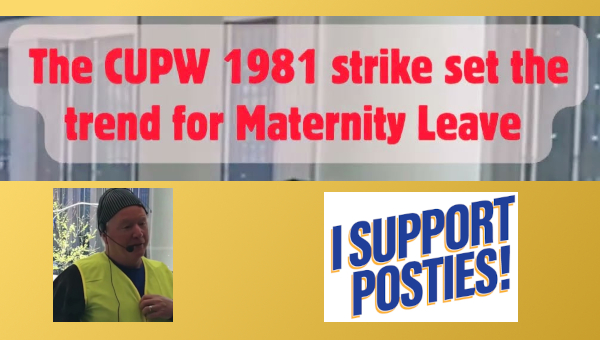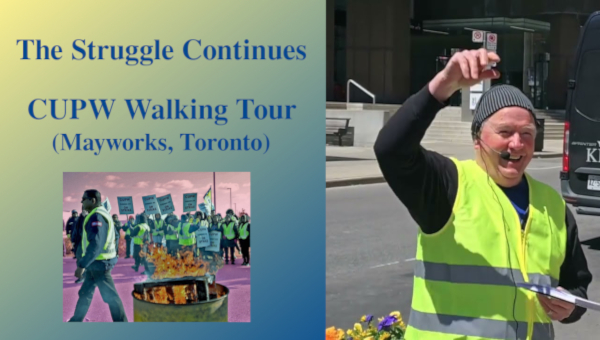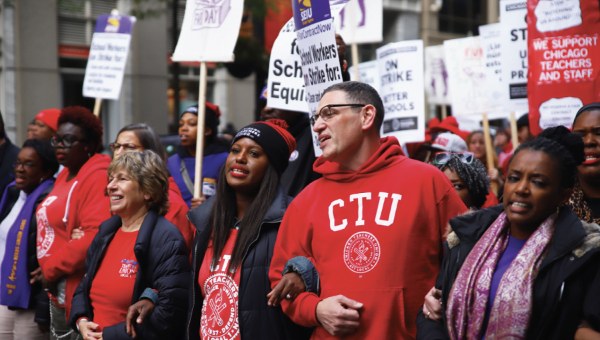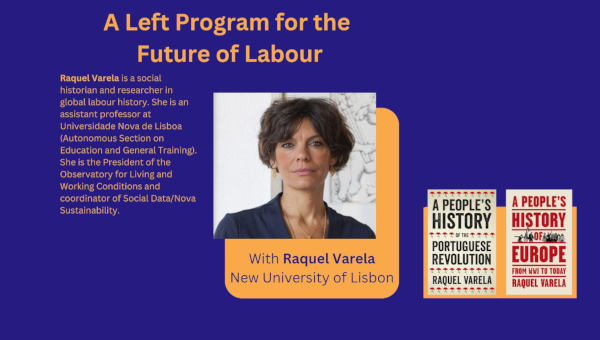Registering the ‘Labour Upsurge’ in North America
After a long four-year hiatus, the Labor Notes Conference is back, and bigger than ever with a record-breaking 4,000 registering. With Amazon and Starbucks workers providing the lead at this year’s conference, it is clear that major events over the last few years have dramatically impacted the form and scope of the American labour movement. These include – but are not limited to – the ongoing COVID-19 pandemic resulting in the deaths of over six-million people globally and over one-million people in the United States; and the current of rampant inflation that is further pinching and financially punishing already income-strapped workers around the world. The COVID-19 pandemic has put labour back on the agenda with an uptick of wildcat strikes occurring alongside other labour actions in response to employers such as Amazon, Starbucks, John Deere, and countless others failing to implement health and safety regulations needed to mitigate the spread of the COVID-19 virus.
This uptick in labour actions has led several journalists, academics, and labour leaders to refer to the current milieu as a ‘labour upsurge’. Although the notion of a contemporary labour upsurge remains contested, with some arguing that reported strikes remain low when placed in historical context, the potential for a revitalized labour movement is mounting with slews of people turning to unions as a crucial site for workplace struggles and broader changes within North American society.
This turn to unions has sparked a series of fundamental questions that were touched on throughout Labor Notes 2022: what is a union; what role does a union serve within the workplace and in the broader community; what forms should unions take today; what relationships should new and emerging unions have with established unions; how should legacy unions aid and assist novel workers struggles; and, importantly, what structural reforms do legacy unions need to undergo in order to orient themselves away from their current business union formations? These are foundational questions and seeing them raised and debated at Labor Notes suggests an array of workers are beginning to see the potential power of unions as sites of political possibility and radical change.
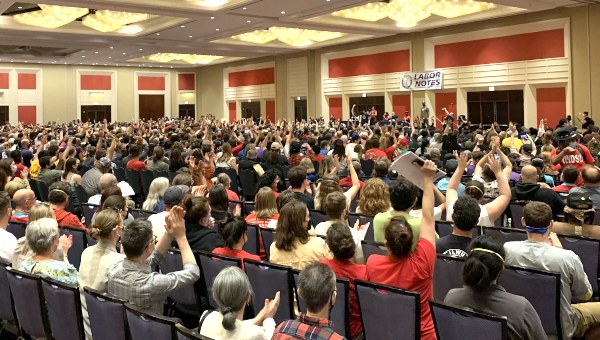
A Variety of Tactics at Amazon on Display
The ongoing labour struggles across all Amazon facilities in the United States reflect well these questions and debates. The diversity of union formations within Amazon’s labour struggle points to a growing interest (and need) in developing new unions which carry the capacity to respond to the changes in workplaces that have emerged under neoliberalism. Yet, they also illustrate the conflicting perspectives workers have toward unions (and perhaps the open-endedness and historical contingency of these issues to begin with). In the panels directed at Amazon organizing, these important debates bubbled to the surface and elicited interesting responses from Amazon workers attending.
Representatives from four distinct yet related Amazon union formations participated in Labor Notes 2022: Amazon Labor Union (ALU); Amazonians United (AU); the Bessemer, Alabama campaign partnered with the Retail, Wholesale and Department Store Union (RWDSU); and Carolina Amazonians United for Solidarity and Empowerment (CAUSE). Two primary schisms have influenced the shape of these unions: first, conflicting perspectives on the necessity and utility of fighting for a legally recognized union with the objective of winning a collective bargaining contract; and, second, whether or not these novel worker-led organizations should develop relationships with or rely on assistance from larger established unions.
The ALU has garnered the most attention recently, becoming the first legal union at Amazon in the United States due to their recent National Labor Relations Board (NLRB) election victory. Although the ALU’s ballot victory marks an important historical milestone for the Amazon labour movement (and even the American labour movement as a whole), the ALU has a challenging road ahead in terms of both receiving union recognition as well as moving from union recognition to the actual bargaining of a contract. Amazon has consistently proven itself to be one of the most aggressive anti-union employers in North America as they immediately contested ALU’s win by initiating an NLRB oppositional hearing. This hearing is still in process and the ALU could still easily become bogged down in a legal dispute over recognition itself, having to divert resources, time, and attention away from organizing within and outside of Amazon’s JFK8 facility in Staten Island.
As many noted, this highlights one of many limitations of focusing too narrowly on receiving legal union recognition, as legal proceedings are often used by employers to entrap unions. Indeed, rather than strengthening workers’ struggles in the hyper-legalistic North American framework for unions there is also the possibility of losing momentum and strength without focusing on shop-floor organizing.
The Bessemer Amazon union drive illustrates similar limitations to achieving legal union recognition. Unlike ALU and AU, Bessemer organizers openly partnered with the RWDSU throughout their campaign. RWDSU has assisted Amazon workers at Bessemer with their union drives as well as with filing subsequent objections against Amazon for both recognition votes held. One of the benefits of working with a larger union like RWDSU is their ability to share a greater number of resources with emergent unions whose workers may not have experience with conducting and organizing union drives. Although the final outcome of their vote remains contested, their partnership with RWDSU has elicited critiques from other Amazon unions, such as the AU, and raised concerns over the extent of the RWDSU’s involvement in Bessemer’s union drive.
AU, on the other hand, as a more syndicalist oriented effort, has openly expressed disinterest in fighting to attain a legally recognized union. Instead, they are focused on building informal workers organizations concentrating on achieving gains within the workplace while providing political education for their members. While AU often acts and operates as a union regardless of their legal standing, a different set of challenges and limitations emerges that shapes their ongoing struggles. For example, without the relative stability of a legally recognized union, the AU will find it difficult to bargain for a contract, which could potentially limit their ability to achieve higher wages and longer-lasting benefits. Furthermore, without being able to win key demands over employment stability and status, the high turnover rate characterizing almost all Amazon facilities will remain a major obstacle to organizing.
Although CAUSE is affiliated with AU, throughout the Labor Notes panels they offered a fourth vision for unionization at Amazon. Based in North Carolina, CAUSE is rooted in the Black Baptist Church tradition and has explicitly tied their organization to the legacy of Black revolutionary political movements like the Black Panther Party. Borrowing from the Panthers, CAUSE has stated their intention to develop a food program in response to workers being unable to feed themselves and their families while working at Amazon. This approach has effectively initiated a fourth union formation that is located within an Amazon workplace but also extends to a broader community. By launching a community food program, additional challenges and struggles will no doubt develop that will shape and inform Amazon workers relations with labour struggles across the Carolinas.
These variations in union formation at Amazon could be seen as a hindrance to getting the organizing done. The divergent views and practices, however, should be seen as the necessary unfolding of a vibrant and complex labour movement. The obstacles and successes that have and will continue to shape the ALU, AU, Bessemer, Cause, and other worker’s organizations found within Amazon facilities could strengthen and embolden the burgeoning American labour movement. These differences should be seen as opportunities for Amazon worker’s organizations to learn and grow from each others experiences in their collective struggle against Amazon. These debates amongst Amazon workers are about re-creating the labour movement and, in some instances, re-inserting a place for socialism within the North American working class.
Reform Caucuses: New Power in the Old Unions
The new and innovative organizing at major companies such as Amazon and Starbucks provided much of the energy at Labor Notes 2022. The conference also offered the opportunity for an intergenerational exchange between young workers riding the wave of organizing at these workplaces and seasoned workers organizing in the more established unions. One form this exchange took was in a variety of sessions that sought to shine a light on what is potentially the site of a further breakthrough for American labour – the rank-and-file caucus. Reform caucuses based in the rank and file that aim to directly challenge stagnant – and often corrupt – union leaderships are not a new development of the North American labour movement. Caucuses of all kinds have had a long history of being involved with Labor Notes, with this year’s conference being no exception. The ubiquitous presence of groups such as Teamsters for a Democratic Union (TDU), Unite All Workers for Democracy (UAWD), and a wide variety of education worker caucuses (organizations of rank and file educators from Chicago, Rochester, and Baltimore, among others) demonstrates that this form of worker agency is here to stay.
A recurring theme at this year’s conference was the need for members to take control over the direction of their unions if they ever hope to make gains over wages and conditions at work. The president of the International Brotherhood of Teamsters (IBT), Sean O’Brien (an endorsee of TDU), used the opening minutes of his Friday night plenary speech to highlight the importance of rank-and-file organizing — before returning to the common themes of standing up to corporate greed and saving ‘middle-class America’. The victory of the O’Brien slate in the 2021 Teamsters election, as well as UAWD’s success in campaigning for a ‘one member, one vote’ policy in the United Auto Workers, has given additional hope to many organizers in some of North America’s largest and historically most powerful unions.
While a strategy of electing reform-inclined candidates alone has obvious limitations, groups taking a rank-and-file-focused campaigning approach by putting workers’ issues ahead of the candidates themselves, have had far-reaching effects. Influenced by the victory of the O’Brien slate especially, members of the Teamsters-affiliated Brotherhood of Maintenance of Way Employees have begun to form their own rank-and-file organization — BMWE Rank and File United. As BMWE members related to conference attendees, organizing in rail offers some unique obstacles. Frequent company mergers, the draconian Railway Labor Act, and not least, a workplace that is scattered across the vast rail network of North America are all day-to-day realities. These challenges necessitate a network of rank-and-file members to organize around major issues of poor working conditions and job security, especially when the elected union leadership has repeatedly opposed engaging in such struggles. BMWE rank-and-file activists are hopeful that their bottom-up approach will be what it takes to replicate the reform victories seen in the IBT at large.
Activists from public-sector employees at the conference also spoke of their eagerness to organize more aggressively against both their bosses and, if need be, their own union leadership. Members of the only recently formed Rochester Organization of Rank and File Educators (RORE) caucus, for example, described their union local — the Rochester Teachers Association — in sadly familiar terms: as having a disengaged and often apathetic membership, an inability to effectively mobilize, as well as an entrenched and corrupt leadership, most blatantly in the form of the local’s president holding an astounding 41-year tenure. Though willing to contest union elections when advantageous, RORE decided to first challenge the leadership where a union can have the most visible and powerful effect, on the shop floor (or classroom floor, as the case may be).
Within the course of only a few months, RORE went from a small group of teachers seeking modest change to a powerful caucus with their own dues and internal structure, capable of executing campaigns and levelling their own demands against the employer, such as a guarantee of internet access for all students and staff during times of remote learning. RORE was able to organize directly with their co-workers on such workplace issues, bypassing the union leadership completely and broadening the possibility of what workers are capable of achieving. Even without controlling the majority of leadership positions, RORE’s worker-led campaign suggests the true potential for democratic change and openings for class-struggle unionism within even the most entrenched of the legacy unions.
The impressive advances in organizing that these caucuses represent was a cause for celebration at Labor Notes. Yet, questions remain. Notably, tensions exist between strategies that seek to capture leadership positions and those that prioritize 1-to-1 relationship building among members. While there was much sober discussion about the need to organize fellow members, there was little talk of what happens if a reform caucus actually succeeds in gaining control of the existing union apparatus. Is it inevitable that recently elected leadership, whether in existing or newly founded unions, will eventually revert back to the old ways of a self-centred business-unionism? If rank-and-file members are able to make and win demands on their own, is it necessary to win formal control of a union to truly transform it? And though the desire of many for a return to a more militant labour movement is clear, what conditions made that kind of militant unionism historically possible?
These are difficult questions to address, and the experience of struggles like those of CORE in Chicago may provide important lessons. They do, however, require more time and space for debate and discussion than a one-weekend conference allows. What is clear, though, is that in terms of broadening the scope of what feels possible for working-class people to win, rank-and-file members organizing and winning in their own unions are making an absolutely vital contribution.
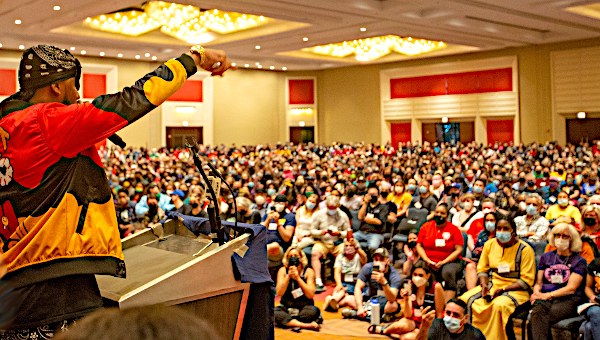
Understanding the Past, Grasping the Present
Many of the issues being raised by newly emerging unions at Amazon and elsewhere are articulated within the structures of the established unions more than the supposed new versus old dichotomy would suggest. Workers seeking to unionize and those in already established unions are increasingly facing the same questions around union bureaucracy, rank-and-file democracy (whatever the trappings of ‘formal’ democratic structures), the class divisions and working-class organization, and the balance between direct action and consolidation.
The main tension that emerges from Labor Notes 2022 is not to be found in the question of whether workers should form new unions or join existing ones. Or even asking where the hopes for a continued upsurge of labour organization resides. Rather it is how union militants, working-class activists, and socialist organizers address the fundamental challenges of building collective structures that workers need to organize. In attempting to face this challenge today, activists in established and emerging unions alike might initially turn to the rich history of the labour movement in the United States and Canada from which to draw important lessons that help contextualize our current context.
Although labour history, and especially the militancy of the 1930s, was referenced throughout the conference by panelists, the context was largely unexamined. The comparative reference was only to suggest the current labour upsurge as potentially more transformative than those of the past. But we need to also be raising more fundamental questions if we are to learn from the past to grasp the present. Why were the 1930s such a transformative moment for labour? What role did explicitly revolutionary political organizations such as the US Communist Party, the Industrial Workers of the World, and the Socialist Party of America, among others, play in key moments of militancy during that time? What specific socio-political events were workers and revolutionary organizations responding to? And, importantly, how do they compare to today? Asking these questions is not to encourage organizers and union activists to look backwards, but rather to encourage the collective learning that puts our current moment in proper context and in perspective the work yet to be done.
It is not just the positive energy of a burgeoning labour revival that Labor Notes 2022 captured so well. It also told us something about the gaps in our collective understanding of labour’s relationship with our past, and our past to the neoliberal present, that remain to be closed. Unions are active and dynamic organizations that develop and respond in relation to the history and conditions of our workplaces and communities. The current challenge is to make our own history, with the past informing our analysis of the present, and encourage the inventiveness of organizing strategies for the struggles yet to come. •


